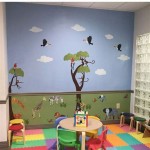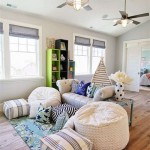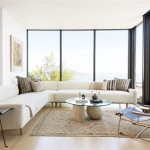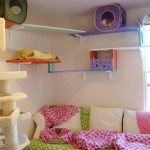How to Decorate Family Room Ideas
The family room serves as a central hub within a home, a place where relaxation, entertainment, and shared experiences converge. Effective family room decoration balances functionality with aesthetic appeal, creating a comfortable and inviting space for all occupants. This article explores several ideas for decorating a family room, focusing on key aspects such as layout, color palettes, furniture selection, lighting, and personal touches.
Optimizing the Room Layout
Room layout fundamentally affects the flow and usability of a family room. Consideration should be given to the room's size, shape, and existing architectural features, such as windows, fireplaces, and doorways. Prioritizing functionality is paramount; for example, creating clear pathways to avoid obstacles will improve the room's accessibility. The placement of furniture should facilitate both conversation and viewing of media, achieving a balance that caters to the family's needs.
A common approach is to create a focal point within the room, such as a fireplace or a large television. Furniture can then be arranged around this focal point to maximize viewing angles and create a sense of visual hierarchy. Sectional sofas are popular choices for family rooms because they provide ample seating and can be configured to fit various room shapes. Alternatively, a combination of a sofa, loveseat, and armchairs can offer greater flexibility in arrangement. The placement of coffee tables and side tables is also crucial, ensuring that they are within easy reach of seating areas.
For smaller family rooms, maximizing space is a key consideration. Wall-mounted televisions can free up floor space, and multi-functional furniture, such as storage ottomans or coffee tables with lift-top mechanisms, can provide additional storage options. Light-colored walls and strategic mirror placement can visually expand the room. Avoiding clutter and maintaining a minimalist approach can also contribute to a more spacious feel.
Larger family rooms may benefit from zoning, creating distinct areas for different activities. For example, one area could be dedicated to watching television, while another could be set up as a reading nook or a play area for children. Area rugs can be used to define these zones and create visual separation within the larger space. The furniture arrangement should reflect the intended use of each zone, with appropriate seating, lighting, and storage solutions.
Selecting a Harmonious Color Palette
Color plays a significant role in shaping the atmosphere of a family room. The choice of colors can influence mood, create visual interest, and complement the room's architectural features. A well-chosen color palette should be cohesive and reflect the family's personal style, while also considering the room's natural lighting conditions. Neutral color palettes, such as shades of gray, beige, or off-white, are a safe and versatile option, providing a calming backdrop that allows for the introduction of bolder accent colors.
To introduce color, consider using accent walls, throw pillows, artwork, and area rugs. Accent walls can create a focal point and add visual depth to the room. Throw pillows and blankets are an easy and inexpensive way to incorporate pops of color and texture. Artwork can reflect the family's interests and add personality to the space. Area rugs can define seating areas and add warmth and visual interest to the floor.
The amount of natural light that a family room receives should also be considered when selecting a color palette. Rooms with ample natural light can handle darker colors without feeling oppressive, while rooms with limited natural light will benefit from lighter, brighter colors that reflect light and create a more airy feel. Cool colors, such as blues and greens, can create a calming and relaxing atmosphere, while warm colors, such as reds and yellows, can create a more energetic and inviting atmosphere.
When choosing a color palette, it is helpful to gather inspiration from various sources, such as magazines, online image galleries, and home décor stores. Creating a mood board can help to visualize the overall look and feel of the room before committing to specific colors. Paint samples should be tested in the room under different lighting conditions to ensure that the colors look as expected. Coordination with existing furniture and décor is also crucial to achieving a cohesive and harmonious look.
Implementing Effective Lighting Strategies
Lighting is a critical element in family room decoration, affecting both the functionality and the ambiance of the space. A well-lit family room should provide adequate illumination for various activities, such as reading, watching television, and socializing, while also creating a warm and inviting atmosphere. Layered lighting, which combines different types of light sources, is often the most effective approach.
Ambient lighting provides overall illumination to the room and can be achieved through the use of ceiling fixtures, such as chandeliers, pendant lights, or recessed lighting. Task lighting provides focused illumination for specific activities, such as reading or working, and can be achieved through the use of table lamps, floor lamps, or adjustable wall sconces. Accent lighting highlights specific features of the room, such as artwork or architectural details, and can be achieved through the use of spotlights, track lighting, or picture lights.
The placement of lighting fixtures should be carefully considered to maximize their effectiveness. Ceiling fixtures should be positioned to provide even illumination throughout the room, while task lighting should be placed close to seating areas or work surfaces. Accent lighting should be strategically placed to highlight the most visually appealing features of the room. Dimmers can be used to adjust the intensity of lighting, allowing for greater control over the mood and atmosphere of the room.
The type of light bulbs used in lighting fixtures can also affect the overall look and feel of the room. LED bulbs are a popular choice because they are energy-efficient, long-lasting, and available in a variety of color temperatures. Warm white light bulbs create a cozy and inviting atmosphere, while cool white light bulbs provide a brighter and more energizing light. Choosing the appropriate color temperature for the family room will depend on the family's preferences and the intended use of the space.
Natural light should also be maximized whenever possible. Keeping windows clean and unobstructed will allow more natural light to enter the room. Light-colored window treatments, such as sheer curtains or blinds, can filter natural light and create a softer, more diffused illumination. Mirrors can also be used to reflect natural light and brighten up darker areas of the room.
Incorporating Personal Touches and Accessories
Personal touches and accessories are essential for transforming a family room from a generic space into a personalized reflection of the family's unique style and interests. These elements can add character, warmth, and visual interest to the room, making it a more comfortable and inviting place to spend time. Incorporating personal mementos, such as family photos, travel souvenirs, and cherished collectibles, can create a sense of history and connection. Displaying these items in a thoughtful and organized way can add personality to the room without creating clutter.
Wall décor is another important element in family room decoration. Artwork, such as paintings, prints, and photographs, can add visual interest and reflect the family's artistic tastes. Mirrors can be used to visually expand the room and create a sense of depth. Shelving can provide storage and display space for books, decorative objects, and personal mementos. Creating a gallery wall, which combines multiple pieces of artwork in a cohesive arrangement, can be a visually striking way to add personality to the room.
Textiles, such as throw pillows, blankets, and curtains, can add texture, color, and warmth to the family room. Choosing textiles in a variety of materials, such as velvet, linen, and wool, can create a layered and visually appealing look. Throw pillows and blankets can be easily swapped out to change the look of the room seasonally or to reflect different moods. Curtains can provide privacy, control light, and add a touch of elegance to the room.
Greenery can also play a significant role in creating a welcoming and relaxing atmosphere in the family room. Plants can add a touch of nature, purify the air, and create a sense of tranquility. Choosing low-maintenance plants that thrive in indoor conditions, such as snake plants, spider plants, and succulents, can ensure that the greenery remains healthy and vibrant. Faux plants can also be used as a low-maintenance alternative, providing the same visual benefits without the need for watering and care.

26 Family Room Decorating Ideas Easy Design
:strip_icc()/cdn.cliqueinc.com__cache__posts__212361__-2030968-1483470364.700x0c-8571e60cad7b42a981ab29ae10b5c153-497b002f87af4747b2ab38b560e7c0fd.jpg?strip=all)
How To Decorate A Living Room 20 Ideas And Common Mistakes

77 Best Living Room Decor Ideas 2025 Unique
:strip_icc()/cdn.cliqueinc.com__cache__posts__261931__family-room-design-ideas-261931-1530304614511-image.700x0c-769d9d53d7c14319bf65658de0d4e44d.jpg?strip=all)
35 Stylish Family Room Décor Ideas And Inspiration

How To Decorate A Living Room 11 Designer Tips Houzz

25 Living Room Interior Design Ideas Havenly Apartment Classic Furniture Styles

Living Room Ideas

15 Small Living Room Design Ideas You Ll Want To Steal

10 Modern Living Room Design Ideas Designcafe

Best White Living Room Ideas For Your Home Design Cafe







